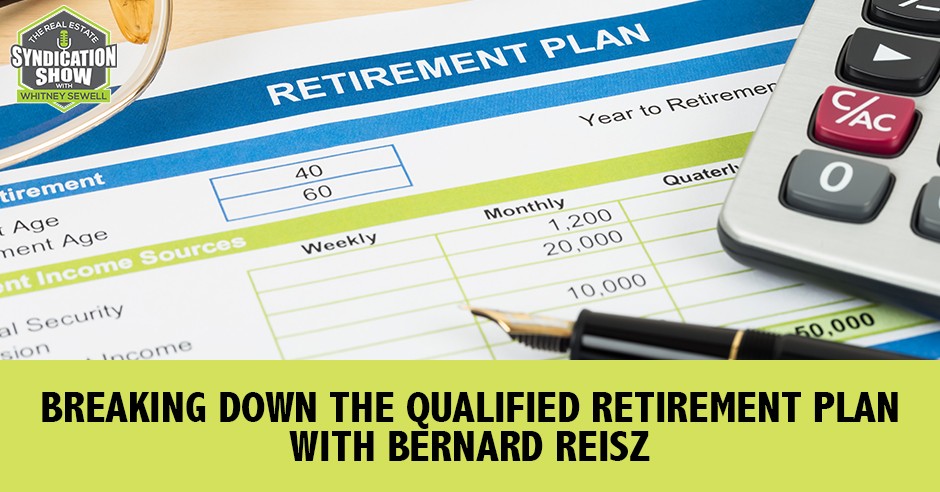
Listen to the podcast here:
Bernard Reisz, a CPA with extensive experience in alternative investment and finance industries, is the founder of 401kCheckbook.com, a company that crafts retirement plans that enhance your current and future finances. Bernard shares how they empower individuals to optimize their finances using proactive and innovative strategies. He provides an integrated approach to tax and financial planning for real estate pros, focusing on their unique profiles and opportunities. Get ready as he unlocks some of the most common questions people have about IRAS, qualified retirement plans such as 401(k), and more.
Our Gracious Sponsor:
Investor Management Services (IMS) is the first and leading investor management software platform for CRE owners and private equity real estate firms who manage outside investors. With 400+ customers currently managing 50,000+ investors and more than $35 billion in equity on the platform, IMS will enable you to save time and resources, drive value, and improve the investor experience. Listeners will receive a 15% discount by using the link imscre.com/podcast. The IMS Platform – Productivity for You; Transparency For Your Investors.
—
Watch the episode here:
Breaking Down The Qualified Retirement Plan with Bernard Reisz
Our guest is Bernard Reisz. Thanks for being on the show again, Bernard.
Whitney, thanks for having me on. I enjoyed doing the first show. I’m glad to be back here. It’s amazing how far we’ve come. This has become a top daily real estate podcast. It’s awesome to see what you’re doing. I’m looking forward to this episode.
I appreciate that a lot, Bernard. I appreciate your expertise. I rely on people like you to give guidance because there’s no way we could know all these things. I’m not going to know it. I’m going to trust somebody like yourself. Bernard is a CPA. He empowers individuals to optimize their finances using proactive and innovative strategies. He provides an integrated approach to tax and financial planning for real estate pros, focusing on their unique profiles and opportunities. I like that, focusing on their unique profiles because everybody’s different. He’s the Founder of 401KCheckbook.com, which gives investors direct control of their tax-sheltered funds for real estate equity and debt opportunities using Checkbook-Control IRAs, Solo 401(k)s and Checkbook Life Insurance.
He is also the Founder of AgentFinancial.com, which provides tax and financial services to real estate professionals, including real estate agents and mortgage brokers. Prior to funding ReSure, Bernard served as the Director of CoMetrics Partners managing an array of engagements involving financial consulting and due diligence. Bernard advises owners of closely-held middle market companies on advanced tax mitigation strategies. Bernard, you’ve done all kinds of stuff. You’re an expert. It sounds like finance. You’re a CPA, so you know the numbers backward and forwards, which is a fantastic skill either to have or to know somebody that has the skills in this business. Thanks again for being on the show. I look forward to our topic. Bernard and I are going to do a few shows about some different topics to clarify some things in his line of work that in the syndication business we all need to be familiar with. Bernard, get us started in what we’re going to talk about and let’s dive in.
By way of introduction, what we’re going to focus on is QRPs and IRAs for investing in real estate, be it equity or debt. It’s a high level. It’s about using IRAs, 401(k)s and other tax-sheltered accounts for investment assets that are off Wall Street, present higher risk-adjusted returns and that many of us want to get into. There are lots of ways to do this. There are lots of subtopics. We’ll try to keep it organized in a manner that’s easily digestible. The first episode will focus on QRP 401(k). We’ll do an episode about IRAs. There are lots of different IRAs and a subsequent episode perhaps to bring it all together, wrap it up and describe what services people can expect.
[bctt tweet=”The Tax Code is not there to tell you how to invest. The Tax Code is there to incentivize you to invest.” username=””]
We haven’t had anyone talk about QRPs in depth and what that is. I’ve heard that mentioned at different conferences. Most people are like, “What in the world is a QRP? I have no idea,” or other people think they need it, but they don’t know for sure. That’s why we got Bernard.
We’re going to try to shed some light on this. It’s good even though anybody reading this should definitely go back to our prior episode where we spoke about using Checkbook IRAs, Checkbook 401(k)s, foundational information but at a very high level. It’s important to know that what we’re focused on is taking those IRAs and 401(k)s that you may be used to using for mutual funds, the stock market and putting those into real estate-based investments without getting into too much detail. That is certainly legal. The Tax Code is not there to tell you how to invest. The Tax Code is there to incentivize you to invest in the way that will give you the highest return over time and give you the biggest nest egg and where to use those tax advantages for the asset choices that you choose and control.
Let’s dive into the QRP 401(k).
QRP is a brilliant abbreviation for Qualified Retirement Plan. There are different types of tax-sheltered accounts that are created by the Tax Code. The traditional IRAs or Roth IRAs are governed by Section 408 and 408A of the Tax Code. Those are IRAs. IRA stands for Individual Retirement Arrangement. Those are accounts for individuals, individual accounts. When you’ve got a SEP IRA, again, it’s always coming back to Individual Retirement Arrangement, even if there’s some business involved in creating the account. The QRP or Qualified Retirement Plans refer to a completely separate group of tax-sheltered retirement accounts. Most of them are governed by Section 401 of the Tax Code. That’s why we’ve got this creatively named 401(k) plan. It’s Section 401 paragraph K, subsection K of the Tax Code that talks about 401(k) plans.
The technical term is a CODA, a Cash or Deferred Arrangement. Qualified Retirement Plans, it’s Section 401. IRA’s are in Section 408. Qualified Retirement Plans do have many advantages over IRAs. They are generally far more complex than IRAs. They’ve got benefits. They’ve got increased investment strategy. They’ve got enhanced tax strategy. They’ve got a whole lot more compliance work out there. QRPs encompass defined benefit plans, defined contribution plans, profit sharing plans and cash balance plan from a purely technical perspective. There’s a whole array of plan structures and plan designs that fall under that rubric.

Within the real estate investment space, you can use all these plans structures for real estate and you can use it even technically if you’ve got a company with thousands of employees in practice. When we talk about using a QRP for real estate, anybody that talks about using a QRP for real estate are talking about a Solo 401(k) plan. Solo 401(k) is not anywhere in the Tax Code. You can read Section 401, the Tax Code, the regulations, the case law, there will never be a mention of Solo 401(k). It’s not a technical tax term. They’re more to explain who this plan is made for and how we can give you a QRP that can give you this incredible flexibility at this incredibly low cost.
QRP and 401(k) are essentially the same thing.
In practice, they’re technically not QRP. From a technical perspective, QRP encompasses many plans. Within the real estate investment space, when we said QRP, we’re talking about an owner-only Solo 401(k). The reason for that is it’s within the Labor Code and Regulations, that’s Section 29 of the US Code. The Internal Revenue Code or the Tax Code, that’s Chapter 26. The Labor Law (ERISA), that’s in Chapter 29 if we want to get technical. It exempts Solo 401(k) plans from almost all the burdens of ERISA. ERISA is the Employee Retirement Income and Security Act. That’s the law that makes retirement plans expensive to manage and complex to manage. Those laws are to protect employees. You can imagine, you’ve got a company, you’ve got employees. The Congress says, “We’re giving you this tax-sheltered account because we want your employees to have the benefit of saving for their retirement in a tax-advantaged way.”
The Congress is concerned that the owners of the business or the highly-compensated employees, the C-Suite, the big shots, they’re going to take advantage of the plan, keep all the good stuff for themselves and not give any of these tax benefits to the employees. To prevent that, there are all sorts of regulations in place requiring annual testing, ACP testing, AVP testing to make sure that everybody’s deriving the same benefit from the plan. It’s two-fold. First, you’ve got to run the plan in a way that meets all these compliance requirements. Secondly, you’ve got to prove it. You have to have administrative work. You’ve got to test. If it turns out you’ve failed the annual test and you’ve got to adjust, it gets to be messy, cumbersome and expensive to run a full blown 401(k) plan especially if you’re going to allow investment in real estate and alternatives.
It gets to be very costly. What we focus on is a business that has no employees other than the business owners and their spouses. When there are no employees that are not owners or their spouses, the Congress says, “We don’t have to apply all these rules because you are the owners and the employees. You’re one of the same or you’re a spouse so we’re going to treat you the same as the owner. You don’t have to follow all this annual testing. You can do whatever you want because we’re not concerned that somebody is taking unfair advantages of the Tax Code.” That’s why we focus on Solo 401(k) or owner-only 401(k) creating 401(k) plans where only eligible participants are owners of the business or their spouses. I know that’s a lot of information.
[bctt tweet=”A very common misconception is that rental real estate income is a business for purposes of qualifying for a QRP; it is not.” username=””]
Parts of it sound complicated, all the annual testing. There’s a whole array of plan structures you talked about. If we’re thinking about using our 401(k) or we’re trying to figure out if we need this thing called QRP, help us determine which we need and why.
Now that we’ve identified and narrowed down which QRP is our focus within real estate. That’s the owner-only 401(k). The question is, is that the plan for you? When is that the plan for you? Who is that for? How do you qualify for it? We do have the IRAs also as a way to get into real estate. Do you want a QRP or an IRA? Which one do you need? Which one is better for you? In general, in terms of the hierarchy of what we want our clients to use, QRP 401(k) is the preferred plan. However, you’ve got to qualify for the owner-only QRP. If you don’t qualify for it, it is not the preferred plan. I can’t emphasize that enough. It’s the preferred plan for those that qualify. It’s the highly un-preferred plan if you don’t qualify. You get to the next year, which will use a Checkbook IRA generally. Your last resort is to take a distribution from your IRA, a taxable plus penalty distribution to get into real estate.
Being that the QRP 401(k) is our preferred structure, what does it take to qualify? A qualified retirement plan has got to be tied to a business, as we say, an owner-only business. What is a business and what isn’t a business for these purposes? A very common misconception and there were a couple of them is that rental real estate income is a business for purposes of qualifying for a QRP. It is not. For those that have rental properties, they’ll know that a great benefit of rental income is that you pay income tax on it but no payroll tax. That shows you that the rental income has a unique status within the Tax Code. It’s exempt from payroll tax. Therefore, it’s not a business to qualify for sponsoring a 401(k). Property management income is great. That’s ordinary income. It’s a trader business. It’s subject to payroll tax. If you’ve got property management income, you can definitely sponsor a QRP.
I was thinking if I have ten single-family homes, that rental business, that I’m not going to qualify. However, if I claim I have my own management company over here that are managing them, then the income for the management company that’s paid by the rental business now all of a sudden qualify.
Yes and no. That concept is a great concept. In practice, you’ve got to know how to implement it. This is another area we see a lot of confusion. People are saying, “I’ve got rental properties, so I’ll classify some of that as property management income.” We know certain people seem to be advocating that people do that. That does not work. The reason for that is very simple. At least without some structuring, it will not work. It definitely can work. Simply taking some of your rental income and reporting it on your tax return as property management income does not change the true nature of that income. You can’t arbitrarily re-characterize income from one type to another. Where you put it on your tax return does not determine its inherent nature.

The IRS audits that. They’ll say, “You tried to trick us because you took some of your rental income that should have been on Schedule E and you put it on Schedule C incorrectly in order to create a QRP. You’re a bad guy. You’re playing games with us.” Once that money gets to your pocket as rental income, you own the property, you’ve got rental income. You can’t have a property management agreement with yourself absent inserting any entities or structuring. While it is doable, it does require some structuring. I’d say that’s a bit beyond the scope of what we want to cover here. It is doable. It’s also important for people to realize that there is a downside to this because what you’ve done when you do that is you take your tax advantage rental income.
There’s no payroll tax on your rental income. When you move that to your Schedule C or however we would structure it to create property management income, you are going to be paying an additional 15.5% tax on that because now that is subject to payroll tax. Is that something you want to do? Is it worthwhile? In many cases, it is. It’s important to note that the analysis is more nuanced than others would lead you to believe. Moving something off your Schedule E is something you may not want to do. It may be a great move. It may not. It needs careful analysis.
I’d like to know who the most common or the best client for QRP versus not using QRP. It seems like this brand-new thing that people are talking about. Who’s that commonly going to be used for the most?
It’s for people that have their own business. For real estate agents, that’s great. They know real estate. They understand it, they appreciate it. They’re all independent contractors. With the gig economy that has emerged, so many more people can qualify. If you’re doing ride sharing, if you’ve become a consultant, anybody that’s got their own business qualifies. It’s okay to be working for somebody else because a lot of these are side gigs. A side gig in most cases is also a business. If it’s something that you’re infrequently doing, it gets to be very questionable. If you’ve got something that you’re running as a business, but it’s part-time, the QRP is for you. To address some of the other misconceptions and some of the things we’ve got to contend with all the time, as people say that, “I was told that I could sell a bracelet on Etsy and I’ve got a business.” A part-time business is a business, but it’s got to be a business.
The IRS says it’s got to be something that you’re engaged in on an ongoing continuous basis to generate a profit. A one-off is not a business. There definitely are various shades of grey of what is or is it the business. We can’t give you conclusive answers about that. We can’t say that when you’re at one extreme, you sell one bracelet on Etsy, that’s not a business. If you’ve set up an LLC, that’s not a business. You’ve got to be doing business. The flip side of that is if you’re doing business, you don’t need an LLC. The IRS wants to know, are you engaged in a trade or business to generate a profit? They don’t care whether or not you’ve got an LLC for that. Perhaps you should have an LLC. There are great reasons to have LLCs for your business. In general, sponsoring a QRP 401(k) is not one of them.
[bctt tweet=”Even in the tax-free world, there are certain cases where things are not tax-free.” username=””]
Why would I pursue a QRP? Why would I do this?
A QRP has two components, the tax component and the investment component. Let’s talk a bit about the tax component. With the QRP, you can get upwards of $56,000 per year in tax-advantaged money, be it tax deductions or Roth money. That’s super powerful. You don’t need a custodian so you can directly put the money into any deal that you want without any custodian involvement. It can be cost-effective and simple. In terms of the investments, you can get into about any type of deal and asset that you’d like. Within the tax advantage space, there’s a tax known as unrelated business income tax. One of the ways you can fall into that tax is by something called UDFI, Unrelated Debt-Financed Income. Even in the tax-free world, there are certain cases where things are not tax-free.
This tax is definitely not something that should deter anybody from using tax-sheltered accounts in most scenarios. It’s absolutely not a deterrent but it’s completely tax-free. It certainly beats even having to deal with a little bit of tax. For QRPs, there is a carve-out. That exempts them from UDFI within the real estate investment space. To touch a bit on UDFI in this segment, we’ll elaborate more on the IRA segment where you’re more likely to encounter it. One of the great benefits of real estate is that you can leverage it. You come in with 25% of the equity. You can get a property. You can leverage up. You had another 75% from a lender, from a bank or a financial institution because they’re secured by this hard asset.
Unrelated that finance income and that could be taxable within an IRA, you’ll hit that when you use leverage. To keep it super simple, say your debt ratio is 75:25. Within an IRA, there is potential for tax on the portion of the deal that was financed with debt. In a QRP 401(k) that does not apply. That’s an incredible benefit. It’s not so much because the tax liability on the IRA will be great because it isn’t. It’s great not even to have to think about it. It’s a nuisance to have to think about tax. Even if the tax bill itself is zero because in real estate, you’re going to have all your regular real estate deductions there. You’re showing a paper loss, there’s no UDFI. UDFI gets $1,000 of freebie on the sale where you may encounter it.
It’s any way capital gains rates. Overall, you only have the tax on the portion of the money that you borrow. Your principal, your equity remains tax-free. The money that you put into the deal is always tax-free. You’ve got to pay some tax on the leverage. That’s on the OPM. It’s a little cost to having the OPM. Try to invest in stock, go to Fidelity and say, “I’ve got $100,000 in my IRA. I’d like to buy $400,000 of mutual funds. Can I have a loan?” That’s not happening. It’s still powerful to put it into real estate and get 75% OPM. QRP 401(k) doesn’t have that, so that’s far better. The biggest benefit perhaps in the QRP is that you have no UDFI. Whoever we can use a QRP for, we will. That’s the first place you want to put people but not always do they qualify.

Where do we start as far as when I’m thinking, “I need to consider this. This is piquing my interest. This is something I need to learn more about?” Am I going to contact somebody like you? If I’m looking at a deal to invest in, what’s the timeframe? How long does that take? How much time should I allow?
We work quickly. You’ve got to respect the fact that you’re working with regular financial institutions. It takes them time to move money around, review paperwork and process it. The great benefit that we offer is that once you get the money, financial institutions are out of the picture and you never have to wait for them again. During the initial setup, when we’re getting the money from your regular custodian into your hands, we’ve got to allow time for them to get the paperwork processed. We want people to allow approximately three weeks of lead time. We may get it done in five days and it may take five weeks depending who’s your counterparty, which financial institution is it. You don’t want to go show up and say, “I’ve got a deal closing tomorrow.” That also results in a high-pressure situation for everybody involved with the transaction. Allow a lead time of three weeks before you get into it.
Anything else about QRP 401(k) that you want to lay out that we need to know or have at least some understanding about?
I appreciate that. I’ll try to make this a complete self-contained segment. There is an enhancement that we’ve always offered within our 401(k)s, which is to create an LLC within the 401(k). It’s not something that we have heavily promoted. It’s purely optional. We see some confusion around that 401(k) LLC versus Checkbook 401(k), so what is that? When we talk about the Checkbook 401(k), Checkbook QRP, all different marketing terms to try to convey to people what this is because we say Section 401(k), they’re not going to understand who it’s for and what it does. We’re talking about a qualified plan. A qualified plan does not need to have any LLC inside it in order for you to get direct control, to have all the tax benefits and much of the asset protection benefits afforded by Labor law.
However, as an optional feature, we’ll put an LLC into the 401(k). It provides enhanced asset protection. It’s an enhancement. It also provides for more streamlined investing. When you invest with a Checkbook 401(k), you’ll be going to the deal to the closing. You’ll be doing the name of the deal and the name of the 401(k). Not everybody is familiar with that and that can throw people off or maybe you don’t want people to know exactly that you’re using your 401(k) for the deal by putting an LLC into the 401(k). The 401(k) would own the LLC. The LLC does the deal. You come to the table with an LLC and that looks like business as usual. It provides asset protection benefits. There are a couple of different aspects of that. Maybe we can talk about that more in the IRA space where we use LLCs in about every structure and provides more streamlined investing. This distinction between we say Checkbook 401(k) and then we say 401(k) LLC, the 401(k) LLC sits underneath the Checkbook 401(k) QRP.
Bernard, you’re an expert in the space. I’m thankful to know you and appreciate you sharing on the show. We’re going to have you back. We’re going to follow up on some other topics that are very important. Bernard, tell the audience how they can learn more about you and get in touch with you so they can dive into their unique situations.
Whitney, thank you so much for having me. I appreciate the opportunity to share knowledge with your audience. The best place to find me and my company is at 401KCheckbook.com and at AgentFinancial.com. We’ve got lots of information, particularly at 401KCheckbook.com: webinars, podcasts and blog posts. We encourage everybody to get educated, get informed. If there’s something that interests you, we’d love to assist.
Bernard, thanks again. I hope everyone reaches out to Bernard when you have these questions when you’re ready to invest with your 401(k) or QRP or figuring that out, what works best for you and your situation. Also, go to LifeBridge Capital and connect with me. I’d be happy to get on a call with you when you sign up on the website and also go to The Real Estate Syndication Show Facebook Group. You can connect with other experts and people like Bernard. We can all grow our business together.
Important Links:
- CoMetrics Partners
- 401KCheckbook.com
- AgentFinancial.com
- The Real Estate Syndication Show Facebook Group
About Bernard Reisz
 Bernard Reisz CPA, empowers individuals to optimize their finances, using proactive and innovative strategies. He provides an integrated approach to tax and financial planning for real estate pros, focusing on their unique profiles and opportunities.
Bernard Reisz CPA, empowers individuals to optimize their finances, using proactive and innovative strategies. He provides an integrated approach to tax and financial planning for real estate pros, focusing on their unique profiles and opportunities.
Bernard is the founder of 401kCheckbook.com, which gives investors direct control of their tax-sheltered funds for real estate equity and debt opportunities using Checkbook Control IRAs, Solo 401(k)s, and Checkbook Life Insurance. He is also the founder of AgentFinancial.com, which provides tax and financial services to real estate professionals, including real estate agents and mortgage brokers.
Prior to founding ReSure, Bernard served as Director of CoMetrics Partners, managing an array of engagements involving financial consulting and due diligence. Bernard advised owners of closely-held middle-market companies on advanced tax mitigation strategies.



